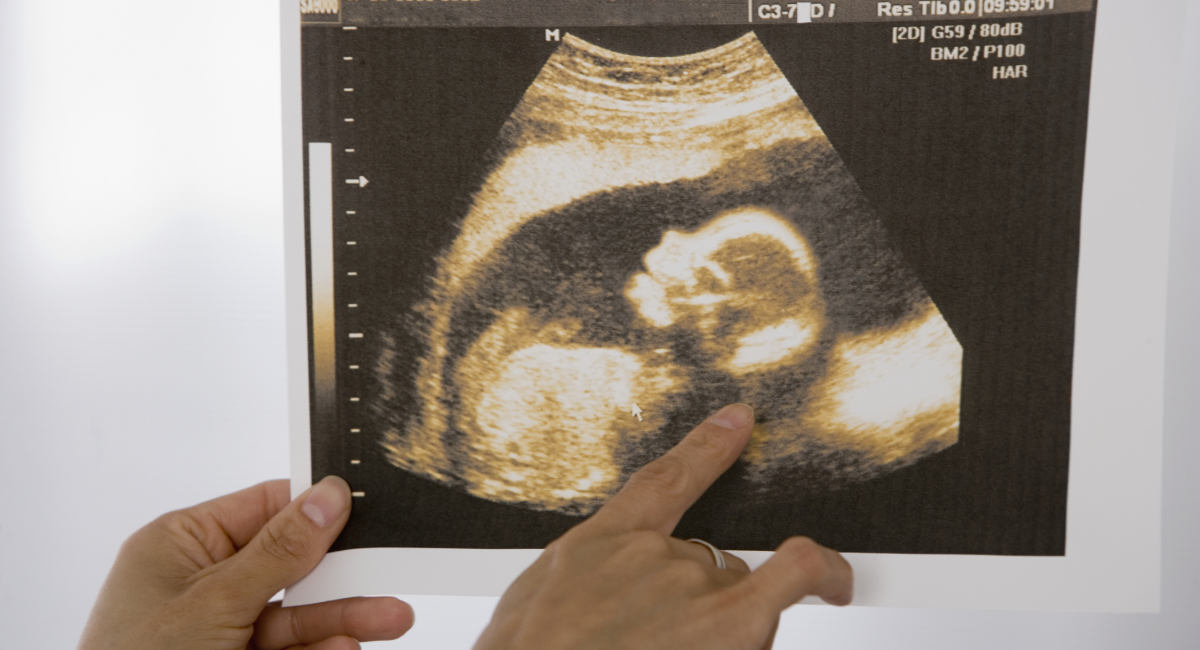In January of 1984 President Ronald Reagan gave a speech before the National Religious Broadcasters which addressed abortion and the ability of the preborn child to feel pain. He stated in part, “This nation cannot continue turning a blind eye and a deaf ear to the taking of some 4,000 unborn children’s lives every day. That’s one every twenty-one seconds… Abortion has denied them [unborn children] the most basic of human rights. We are all infinitely poorer for their loss.”
The president went on to state, “Medical science doctors confirm that when the lives of the unborn are snuffed out, they often feel pain, pain that is long and agonizing… How can we survive as a free nation when some decide that others are not fit to live and should be done away with. I believe no challenge is more important to the character of America than restoring the right-to-life to all human beings.”
President Reagan’s words were immediately challenged by Dr. Ervin Nicholas, a director of practice activities for the American College of Obstetricians and Gynecologists (ACOG), an organization that by that time had fully sold out to the full abortion agenda. In February 1984, Nicholas told the American Medical News (AMN) that he was unaware of any evidence that pain is perceived by a preborn child, calling it “neurological reflexes” not to be interpreted as pain.
His claim was quickly rebuffed by Vincent Collins, professor of anesthesiology at Northwestern University in Chicago, who told AMN, “A fetus shows the precise behavior as you and I in avoiding pain. It is not a reflex, but an actual aversion to a needle or chemicals. He squirms away from noxious influence.”
Collins pointed out the following:
- The cortex is developed between four and five weeks of age.
- Reflex actions can be observed between four and five weeks of age.
- Brain waves are detectable between six and seven weeks.
- Nerves connecting the spinal cord to peripheral structure have developed between six and eight weeks.
- Adverse reactions to stimuli are observed between eight and ten weeks.
- Neurotransmitters capable of sending pain signals to the brain are present at 12 weeks.
- Opiate receptors, designed to provide analgesia, can be seen at 12 weeks.
Collins claimed to AMN that the medical community has ignored fetal pain because “doctors don’t want to dwell on it” and are afraid “women who have had abortions will develop guilt reactions.”
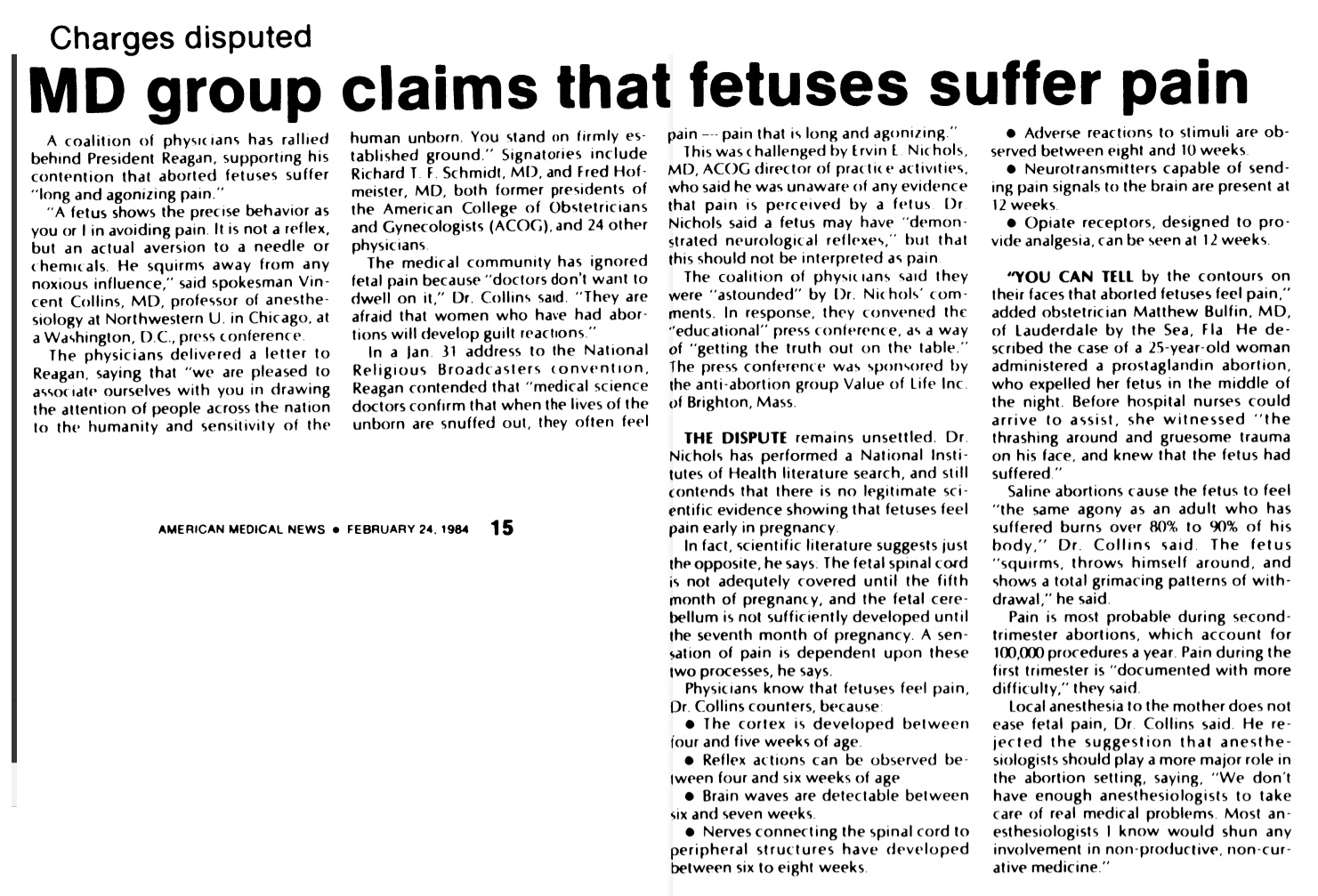
American Medical News MD Group claims fetuses suffer pain 02241984
Collins was not alone. On February 13, 1984, former ACOG presidents Dr. Richard T. F. Schmidt, Dr. Fred Hofmeister along with several other medical professionals signed onto a letter addressed to President Reagan to draw America’s attention to the “humanity and sensitivity of the human unborn.”
It read, in part:
That the unborn, the prematurely born, and the newborn of the human species is a highly complex, sentient, functioning, individual organism is established scientific fact. That the human unborn and newly born do respond to stimuli is also established beyond any reasonable doubt.
The ability to feel pain and respond to it is clearly not a phenomenon that develops de novo at birth. Indeed, much of enlightened modern obstetrical practice and procedure seeks to minimize sensory deprivation of, and sensory insult to, the fetus during, at, and after birth.
Over the last 18 years, real time ultrasonography, fetoscopy, study of the fetal E.K.G. (electrocardiogram and fetal E.E.G.(electroencephalogram) have demonstrated the remarkable responsiveness of the human fetus to pain, touch, and sound. That the fetus responds to changes in light intensity within the womb, to heat, to cold, and to taste (by altering the chemical nature of the fluid swallowed by the fetus) has been exquistely documented in the pioneering work of the late Sir William Liley — the father of fetology.
Observation of the fetal electrocardiogram and the increase in fetal movements in saline abortions indicate that the fetus experiences discomfort as it dies. Indeed , one doctor who, the New York Times wrote, “conscientiously performs” saline abortions stated, “ When you inject the saline, you often see an increase in fetal movements, it’s horrible.”
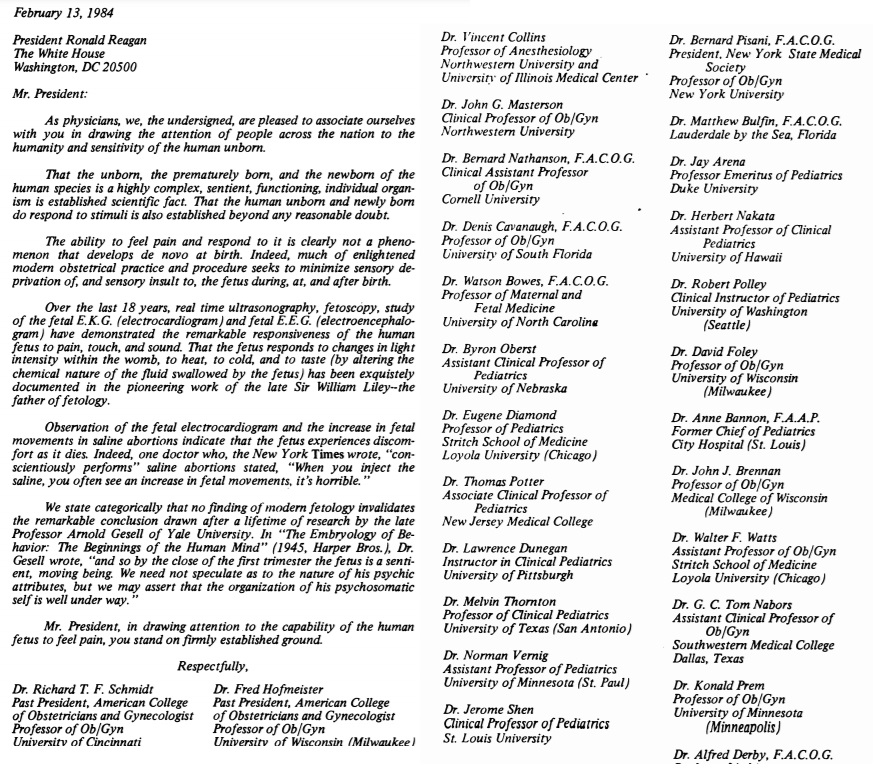
ACOG past presidents 1984 letter to Ronald Reagan validating fetal pain
Then, in a February 26, 1984, op-ed published in the New York Times, ACOG fellow William J Hogan, MD also called Nicholas out. “As a practicing obstetrician-gynecologist and a member of the American College of Obstetricians and Gynecologists, I am dismayed that Dr. Ervin E. Nichols, a representative of the college, has challenged President Reagan’s assertion that the unborn child feels pain when his or her life is being snuffed out by abortion (news story Jan. 31),” Hogan wrote.
“Electrical brain waves have been shown to be functioning as early as 40 days (H. Hamlin, ‘Life or Death by E.E.G.,’ J.A.M.A, Oct 12, 1964). The nervous system is intact and functioning in a ‘total pattern response’ by the sixth week of intrauterine life (Leslie B. Arey, ‘Developmental Anatomy’ 6th Ed., W. B. Saunders Co., 1954),” he added.
Hogan went on to quote the father of modern fetology, Dr. William Liley, who he claimed had shown that “fetal comfort determines fetal position.” Quoting Liley, Hogan wrote, “He is responsive to pain and touch and cold and sound and light. He drinks his amniotic fluid, more if it is artificially sweetened, less if it is given an unpleasant taste. He gets hiccups and sucks his thumb.’ (‘Liberal Studies,’ ‘A Case Against Abortion,’ Whitcombe & Tombs, Ltd., 1971).”
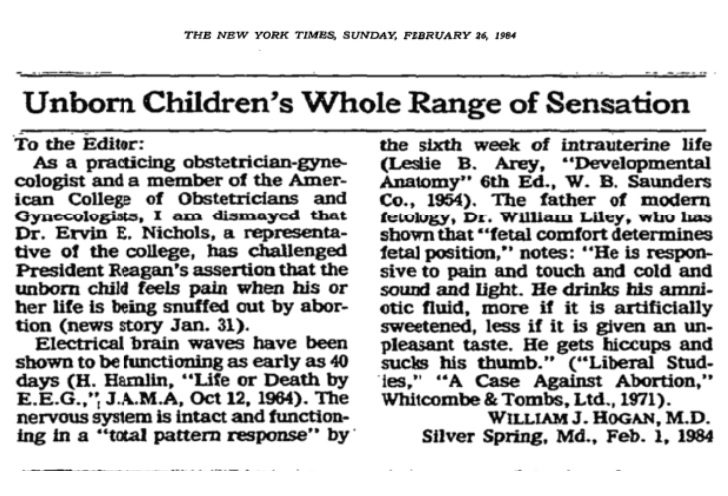
ACOG member confirms preborn child feels pain (New York Times 02261984)
In 1985, Collins coauthored Fetal Pain and Abortion: The Medical Evidence with Steven R. Zielinksi, M.D. and Thomas J. Marzen, Esq. They wrote:
Functioning neurological structures necessary for pain sensation are in place as early as 8 weeks, but certainly by 13 1/2 weeks of gestation. Sensory nerves, including nociceptors, reach the skin of the fetus before the 9th week of gestation. The first detectable brain activity occurs in the thalamus between the 8th and 10th weeks. The movement of electrical impulses through the neural fibers and spinal column takes place between 8 and 9 weeks gestation. By 13 1/2 weeks, the entire sensory nervous system functions as a whole in all parts of the body (except in the skin or the back of the head).
Concurrent with the development of the sensory structures is the emerging responsive behavior of the fetus. By the end of the 5th week, a tap on the mouth of the fetus will cause the lips to draw back. By 10 weeks, the palms of the hands are sensitive to touch, and at 11 weeks the face and extremities likewise respond to tactile stimuli. By 13 1/2 weeks, these responses are sufficiently elaborate and sufficiently avoidant to warrant the definite conclusion that the fetus responds aversively, not reflexively. They evidence an integrated physiological attempt to escape noxious stimuli. In response to experiments performed on 12 to 16 week fetuses, movements of the head, body, and limbs have been observed. These movements were vigorous, and consisted of ventro-or dorsoflexion of the trunk, flexion of the limbs, and turning of the head, indicating the presence of acute fetal pain. It is agreed that a fetus must be heavily sedated before intrauterine manipulation, such as transfusions, because such painful stimuli cause the fetus to move, making the procedure difficult.”
ACOG denies fetal pain
Despite evidence to the contrary, in 2011, ACOG suggested that “Recent and rigorous scientific reviews have concluded that there is no evidence of fetal perception of pain until 29 weeks at the earliest (third trimester is 28–40 weeks).” Today, the ACOG states, “the fetus does not even have the physiological capacity to perceive pain until at least 24 weeks of gestation…This capacity does not develop until the third trimester at the earliest, well past the period between 20 weeks and viability.”
ACOG’s claims were disputed recently by John Bockmann who co-authored Reconsidering Fetal Pain, published in the British Medical Journal, with pro-abortion neuroscientist Dr. Stuart Derbyshire. Research reviewed by Bockmann and published in his Twitter thread reveals that ‘previable’ babies can feel pain by 12 weeks (3 months) — much earlier than the 24-week to third trimester time frame claimed by ACOG.
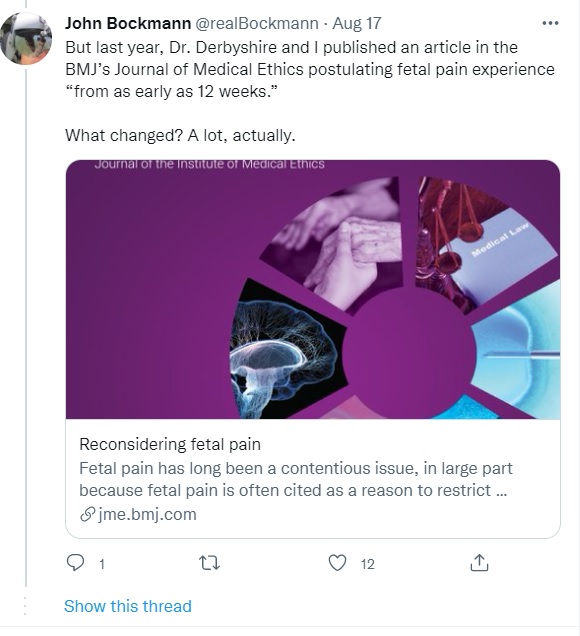
John Bockmann tweets fetal pain research to ACOG (Image: Twitter)
Fetal pain will no doubt be an important topic as the Supreme Court is set to take up a case out of Mississippi (Dobbs. v. Jackson Women’s Health Organization) to test the Constitutionality of a law prohibiting previable abortions after 15 weeks. And, while ACOG continues to cover for the abortion industry by signaling opposition to the claim that preborn children can feel pain very early in development, it is important for the public to know the facts about human development.
“Like” Live Action News on Facebook for more pro-life news and commentary!

